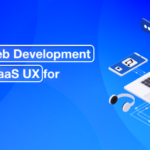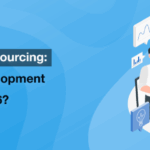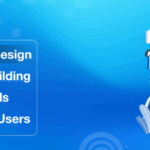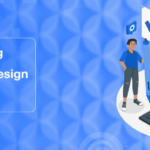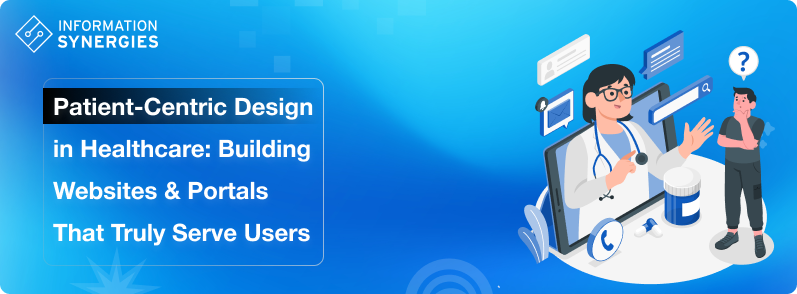
While quality care is important, today’s patients demand more from their healthcare than ever before: a seamless digital experience in which interacting with one’s provider is both effortless and reassuring. This is where Patient-Centric Web Design takes on a transformative role.
Not too long ago, all a healthcare website needed to show was a phone number and an address. Today’s healthcare providers require complex online ecosystems that are completely focused on patient needs, with secure portals, telemedicine, and mobile apps. As a trusted partner, Information Synergies, LLC offers intelligent system design to healthcare organizations through custom web development and digital solutions aimed at enabling both patients and providers.
Understanding the Patient Journey: What Patients & Providers Actually Need
Understanding the patient journey is a key ingredient in any successful digital healthcare experience. Every one of those interactions-from searching online for a clinic to reviewing test results, is a touchpoint in and of itself. Mapping out this journey uncovers precisely what patients need at any given time and where frustration points occur.
Key patient touchpoints include:
- Website discovery and engagement: Patients typically find a provider online through searching; hence, responsive, easy-to-navigate websites are a must.
- Telemedicine interactions: Telemedicine interactions will be enabled through the development of a telemedicine platform that provides secure, high-quality video consultations, reducing time and offering convenience to patients.
- Patient portals: Well-designed patient portal development solutions provide patients with instant access to records, test results, and messaging features.
- Mobile access: Ensures that the patient can manage appointments, medications, and reminders anywhere at any time using mHealth App Development.
- Data understanding: Health Data Visualization lets patients understand health charts and test trends and progress in a comprehensible, intuitive way through visualization.
Today, patients want simplicity, accessibility, and transparency. And if digital solutions are built around their needs, there can be much stronger engagement, better satisfaction, and greater trust.
Core Design Principles for Healthcare Websites & Portals
Accessible & Responsive Design
Every healthcare platform should address Healthcare Website Accessibility for all, whether it’s for elderly patients or those with disabilities. Its responsive design will keep the experience seamless on desktops, tablets, and mobile phones.
Accessibility best practices include:
- Clear typography and color contrast
- Keyboard navigation and screen reader compatibility
- Simple, patient-friendly language
Intuitive Navigation & User Experience
They should not have to wrestle with finding what they are looking for. Effective Patient-Centric Web Design provides minimum clicks, very clear menus, and intuitive task flows. Examples of such might be “Book Appointment,” “Access Test Results,” or “Contact Doctor.”
Empathetic Visual Communication
The visual design should convey care, safety, and professionalism. The imagery should portray real patients and health scenarios; with Health Data Visualization, the most important insights about their health are easily conveyed and understood by the patients.
Security and Trust
Trust is paramount when it comes to health care, so every web or portal design from Day One should have Healthcare Compliance and Security Solutions such as encryption, HIPAA compliance, secure logins, and audit trails.
Customization and Integration
Each health care provider operates with different workflows and different systems. Custom Healthcare Solution Development provides for the seamless integration of portals, EHRs, and telemedicine platforms by employing secure custom web development based on specific organizational goals.
Services That Power Patient-Centric Digital Platforms
Information Synergies, LLC provides complete digital solutions by putting the patient first. It is one of the leading service providers in web design.
- Website & Portal Development (Patient-Centric Web Design): A modern, patient-centric web design with a mobile-friendly layout that enables easy navigation.
- Telemedicine Platform Development: Real-time video consultation, scheduling, and secure communication tools.
- Patient Portal Development: Customized dashboards will let patients access their medical records, lab results, and provider messaging.
- Health Data Visualization: Interactive Dashboards; raw medical data will be presented as clear, actionable insights.
- Mobile Health (mHealth) App Development: This includes the development of mobile applications for patient engagement and remote care.
- Healthcare Compliance and Security Solutions: Securing end-to-end data, encryption, and maintaining HIPAA compliance.
- Custom Healthcare Solution Development: Custom, scalable systems are designed via custom web development to cater to unique provider needs.
These solutions are designed not only to meet compliance standards but to make every digital healthcare experience truly human-centric.
Practical Steps to Build a Patient-Centric Healthcare Platform
Building a patient-centered digital platform demands a considered strategy, thoughtful design, and iterative development.
1. Define User Personas and Map Workflows
Identify the different types of patients, such as first-time visitors to your site, chronic care patients, or tech-savvy mobile users, and what each distinct group expects of your site.
2. Design with Accessibility in Mind
Ensure that Healthcare Website Accessibility is considered and given importance at the initial stages of responsive design and inclusive interfaces.
3. Integrate Patient Tools
Bring together key functionalities such as appointment scheduling, development of the Telemedicine Platform, and portal messaging into one unified experience.
4. Ensure Security and Compliance
Implement solutions for healthcare compliance and security from day one, including encryption, authentication, and HIPAA-compliant handling of data.
5. Prototype and User-Test
Get feedback directly from patients and healthcare staff; iterate until the platform is effortless to use.
6. Measure Success
Performance Indicators-tracking: number of logins via the portal, completion of appointments, patient satisfaction, and use of mobile apps.
7. Scale and Improve Continuously
Add advanced modules such as predictive analytics, Health Data Visualization, or integrated mHealth apps to evolve the platform with growing patient needs.
Example Scenario: Transforming Patient Experience Through Design
Information Synergies, LLC is called in to redesign the outdated website and patient portal of this regional healthcare network.
The solution includes:
- Fully redesigned website based on the principles of Patient-Centric Web Design: clarity in navigation, modern visuals, and responsiveness on mobile.
- A secure patient portal development solution that offers access to medical records, appointment scheduling, and direct provider messaging online.
- Potent integration of the Telemedicine Platform Development for virtual visits; this reduces congestion in-person.
- Improved Health Data Visualization: Dashboards that give all patients the ability to track lab results and monitor treatment progress easily.
- Comprehensive Healthcare Compliance and Security Solutions: safely manage data in a regulatory-compliant manner.
- A Mobile Health App Development component, extending engagement beyond the desktop environment.
Results: The network realized a 45% increase in patient portal utilization, while the no-shows decreased by 30%. There was also a significant rise in the rating of patient satisfaction.
Common Challenges & How to Overcome Them
- Balancing Functionality with Simplicity: Core functionality, such as booking, messaging, and results, should be first; then expand.
- Integrating Legacy Systems: Use Custom Healthcare Solution Development to securely connect the existing EHRs and patient databases.
- Ensuring Cross-Device Consistency: Invest in the development of mobile health applications to ensure consistent user experiences across multiple platforms.
- Maintaining Compliance While Innovating: Embed Healthcare Compliance and Security Solutions during design and testing, not as an afterthought.
- Driving Adoption: Educate patients through onboarding guides, portal walkthroughs, and in-office awareness.
Conclusion: The Value of Patient-Centric Digital Design
Putting patients at the center of digital strategy pays off for all constituents: patients, providers, and health care organizations. Thoughtful patient-centric web design, underpinned by secure patient portal development, insightful health data visualization, and mobile connectivity, increases satisfaction and operational efficiency.
By utilizing Custom Healthcare Solution Development in conjunction with custom web development, providers are able to ensure their digital ecosystems evolve alongside the needs of their patients. Whether you are developing a new telemedicine platform or upgrading your existing healthcare portal, with the help of a trusted Web Design service provider, each interaction will support better care and stronger relationships.
Your patients deserve a digital experience that is as compassionate and capable as the care you deliver.
Contact Information Synergies, LLC today for a consultation and learn how a patient-centric digital strategy can transform your healthcare organization.
